Every team member at SEER is a forward-thinking creative at heart (yes, even the technical junkies). On a typical afternoon, you can usually find a group brainstorming new ways to reach link nirvana with an idea that will generate a year's worth of links overnight. It is contagious and one of the benefits of working for a company that strives for cutting-edge link building strategies. Sometimes, however, it's easy to forget that the competitive landscape holds many clues that can point you on the path toward creating your very own RCS asset.
Personally I am a big fan of competitive analysis for link building strategies and opportunities. Even if that's not your thing, it's always a great idea to keep an eye on what competitors are doing, especially as more and more SEOs take an RCS approach. As SEER continues to preach the good word of RCS, (hey, we are in the “Search Church” after all) more of your competitors will be adopting strategies to build high-value, linkable assets. Now more than ever it’s crucial to keep your finger on the pulse of the assets your competitors build.
With traditional competitive analysis we often analyze what types of links our competitors are building. Here are seven ways you can look beyond external links and see what pages on a site are pulling in these types of links and what types of content your competitors are releasing. Don't forget that we're not just looking for popular content and assets; RCS flops are also very valuable and can save you from a lot of work on content with little appeal. I tend to find that competitors operate in different ways, and while you might use some or all of these tips in some situations, you have to approach each competitor with a fresh slate each time.
1. Links (Top Pages)
As SEOs we know that links are a good indicator of the popularity of a page, which is the goal of our RCS to begin with. There are a number of tools that can help you identify the top linked pages of your competitors but my favorite is Ahrefs.
Step 1
Enter the root domain of your competitor (ex: seerinteractive.com)

Step 2
Make sure you’ve selected *.domain/* because this will allow you to see all of the subdomains of a domain which is sometimes where RCS lives.

Step 3
Click on the “Top Pages” tab
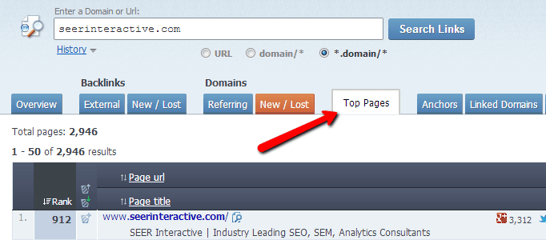
Step 4
Click “Referring Domains” to sort by Descending Order and you will see the top-linked pages on the site. Browse through here to find important assets from your competitors.
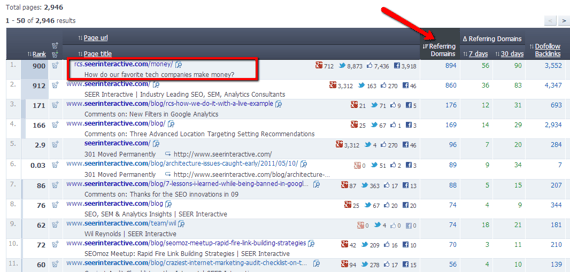
Note: Open Site Explorer also has a "Top Pages" tab but I find Ahrefs is much easier to jump in and sort quickly.
2. Social Shares
Another important indicator of an asset's popularity is social shares. The beauty of RCS is that you are creating a valuable resource and as a result it will encourage sharing across social media (which leads to more exposure and as a result hopefully more links).
While Ahrefs does display social shares, the data isn't easily sortable. So, I created a Google Doc that will pull in social signals for whatever URL you need.
The doc pulls from the SharedCount API in bulk. If you need to rewrite the formula somewhere else in this document you can use the function =shareCount(A2) and replace "A2" with the cell you need to check. The metrics it can pull are Tweets, Google +1's, LinkedIn Shares, Facebook Likes, Comments, & Shares, and shares from StumbleUpon, Delicious, Pinterest, Reddit, & Digg.
Bonus Tip: This doc is also a great place to keep all of your internal RCS to check social signals all in one place!
Another great tool you can use to bulk check social metrics is Netpeak Checker, which is also free (more on that below)!
3. Follow Competitors on Social Media
Think about the last time you launched an RCS asset - didn't you promote it like crazy through social media channels? By following competitors' social media channels you'll be able to see when they launch an asset they want to promote.
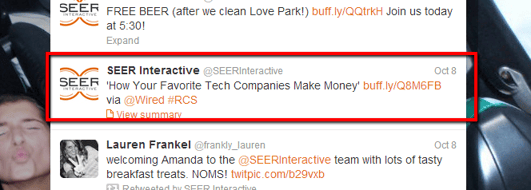
Another great way to look back on all of your competitors' tweets to dig up their old RCS is by using All My Tweets.
Step 1
Go to AllMyTweets.net, type in your competitor's Twitter handle and click "Get Tweets".
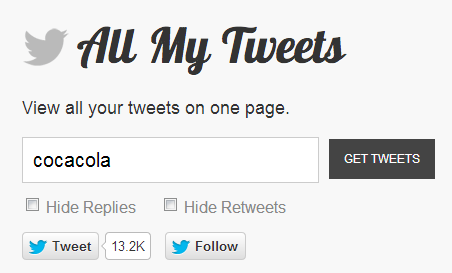
Step 2
All My Tweets will pull a list of up to 3200 tweets. You can even choose to hide replies and/or retweets. From here, it's easy to browse through and identify when your competitor is linking to a resource, and if they are linking to an RCS asset they created.
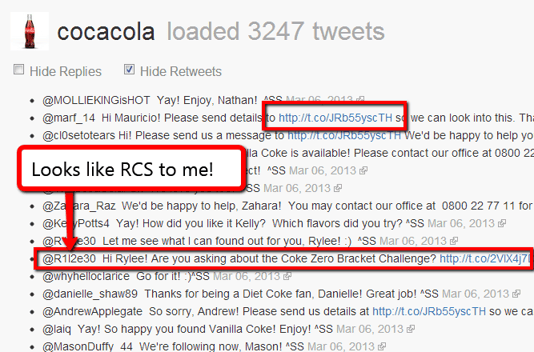
For some industries (I'm looking at you SEOs) this is more difficult as I Buffer several articles every day filling my feed with links. For most industries however, this is a useful exercise.
Pro Tip: Seasoned scrapers can scrape all of the URLs from this page and sort through them in Excel!
4. Google Alerts
This is a mandatory SEO practice even beyond looking for RCS. You should set up a Google Alert for each of your competitors so you know when they are mentioned across the web. By doing so you'll get inbox alerts tracking your competitor's every move - kind of creepy, right? I've found this is REALLY great for industries where competitors are frequently engaging in large sponsorships or other "offline" RCS that draws a lot of press.
Step 1
Go to http://www.google.com/alerts
Step 2
Enter your "Query" in the "Search Query" box - In this case you can just use your competitor's name. You'll get a preview of your query on the right.
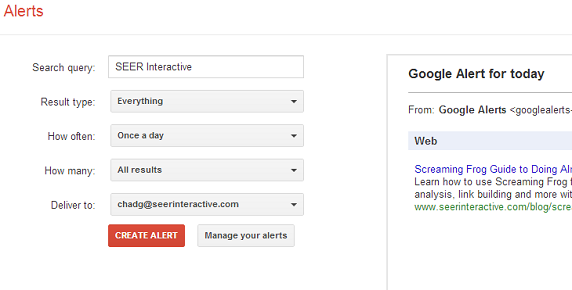
Step 3
Result type: For this purpose we'll select "Everything" How often: "Once a day" unless you really like getting emails How many: "All results" - make sure you select this so you maximize the amount of alerts you receive Deliver to: You can select your email address or subscribe to a feed via your favorite RSS reader
Bonus Tip: Google Alerts are great for automating a lot of your other SEO tasks. They're especially useful for prospecting with a query that you find yourself using often.
5. Advanced Search Queries
Advanced Queries are a way for you to get more specific with your Google searches. We can use this to our advantage when searching for the type of content that is typically associated with RCS strategies (like infographics and PDF case studies)
Infographics
Replace your competitor's domain and search Google for - site:mcdonalds.com "infographic"
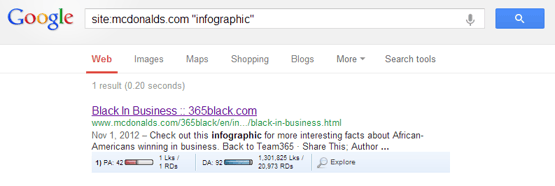
Case Studies, White Papers & Other PDFs
Replace your competitor's domain and search Google for - site:seomoz.org filetype:pdf
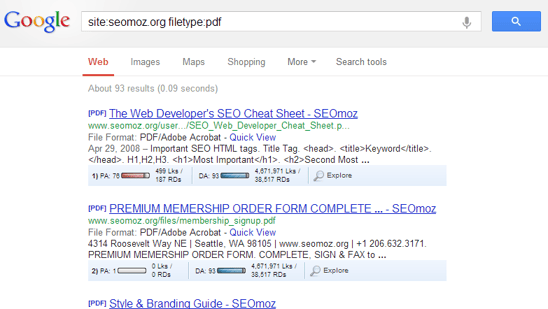
6. Anchor Text
Another way to use Ahrefs to find RCS is to scan the anchor text tab looking for patterns. While a lot of RCS is linked to by branded anchors, if something is really taking off it will often show up in some form of anchor text. Essentially you will follow the same steps from the first "links" section above but this time you're going to click on the "Anchors" tab.
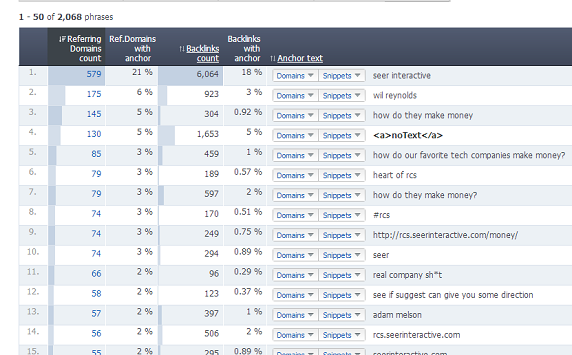
Here we can clearly see evidence of our Tech Companies RCS asset. If you find an anchor that peaks your interest, you can dive into the domain and find what page it's linking to.
7. Screaming Frog
Screaming Frog is an amazing tool for SEOs. For tips on getting started, see Aichlee’s massive post "Screaming Frog Guide to Doing Almost Anything: 55+ Ways of Looking at a Tool".
A “spider” like Screaming Frog will crawl every page on a website and return valuable information about each page. You can use Screaming Frog to crawl a competitor’s site and find important images (infographics, pdfs, other assets).
You can also use it to export every single page from a competitor's site and then run reports to get important metrics on those URLs.
Step 1
Open up Screaming Frog and type in your competitor's URL, then click Start.

Step 2
Once the spider has finished crawling the entire site (paid license needed for more than 500 URIs) export "All" under the "Internal" tab. Bonus tip: To find infographics, export images; to find case studies or white papers, export PDFs.
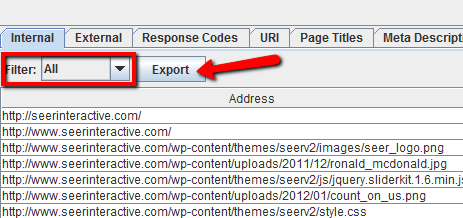
Step 3
Open up the CSV and copy all of the Page URLs.
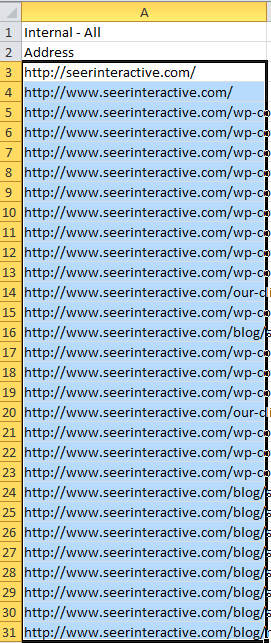
Step 4
Gather relevant metrics using your favorite tool and sort in descending order to find popular pages. For this example I'll jump over to the free Netpeak Checker I referenced before.

Note: Netpeak Checker is great at pulling metrics from multiple source. Be sure to check out the tool for a complete listing of what data you can pull in bulk for your URLs.
Bonus Tip: Look Internally For Hidden #RCS
The truth is you might have some RCS you didn’t even know about! Before you go crazy trying to tap your brain for a great RCS idea, look at what pages are currently getting links and shares via your site. Often you can find something you never intended to take off as a linkable asset that you can re-position as an active link building strategy. Analysis of your own top pages is a lot easier since you can access GA & WMT data to find your top pages and assets.
Google Analytics
Step 1
Log in to Google Analytics and in the left navbar navigate to Traffic Sources > Sources > Search > Organic (This is provided in case you don't have your own organic profile already setup). Note: If you want to see your all-time top pages, be sure to change the date range.
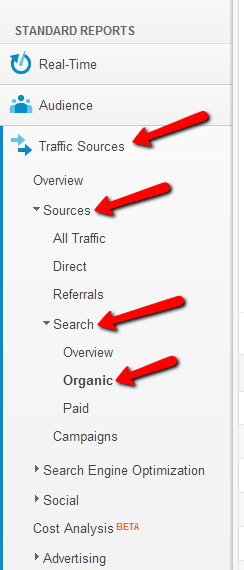
Step 2
Select "Landing Page" as your primary dimension and your top pages will be listed, sorted by visits.
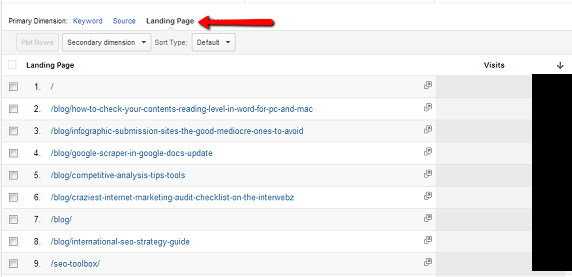
Webmaster Tools
Step 1
Log in to Google's Webmaster Tools and click the Traffic > Search Queries drop down in the left navbar. Note: If you want to see your all-time top pages, be sure to change the date range.
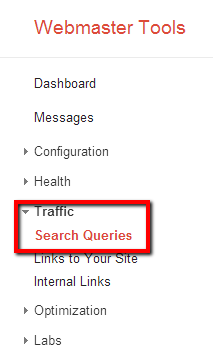
Step 2
Select the "Top Pages" tab at the top of the data. This will list out your top pages by impressions and clicks. NOTE: This will not account for subdomains that are setup in a different WMT Profile (ex: our rcs.seerinteractive.com asset)
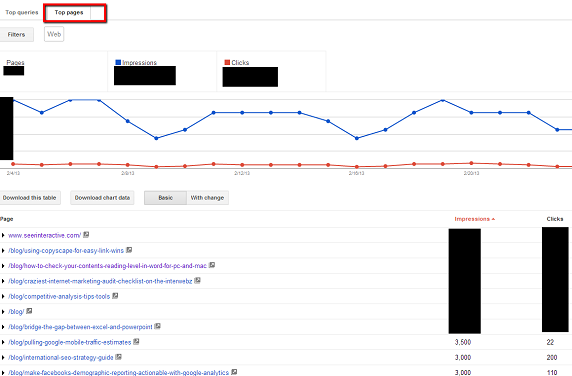
Competitive analysis is more of a testing ground than it is one set of steps. It's like an epic scavenger hunt where you are trying to uncover as much information as you can about your competitors. While RCS might make your competitive analysis more challenging, hopefully these tips above will help you quickly discover what large assets your competitors are launching.
How do you find your competitors' RCS and linkable assets? Comment below to share your thoughts!
For more SEO tips you can follow me on Twitter @chadgingrich or on Google+.


